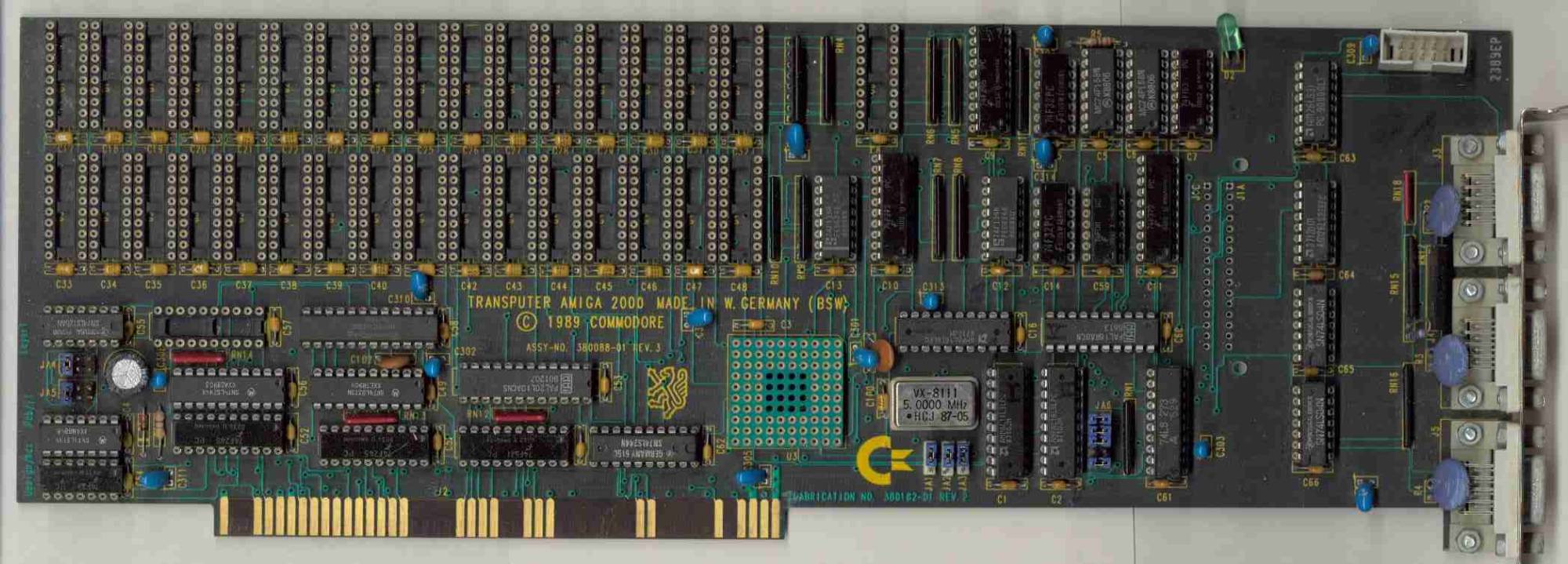"…sequential computers are approaching a fundamental physical
limit on their potential power. Such a limit is the speed of light…"
![]()

|
The Amiga Transputer was proposed by Tim King (who had previously ported TripOS to the 68k) and several others at Metacomco. The company had developed the custom OS, Helios to interact with the host operating system. The project was demonstrated at several Commodore Amiga shows, but the company never bought the technology. It was later sold as the Atari Transputer.
Dave Haynie gave the following thoughts in a posting to the TeamONE mailing list:
Subject: Re[2]: Amiga Transputer query
Date: Wed, 8 Jul 1998 23:25:33 -0400 (EDT)The Transputer was certainly interesting. INMOS (the parent company at
the time, the same guys making the original RAMDAC used for the IBM VGA
card) seemed to want to make Transputers work essentially as front ends
to every piece of your system. Rather than talk talk to a hard disc,
you'd talk to a Transputer fronting the hard disc. Same with video and
other I/O.So conceptually, the processor could be used like an embedded CPU. It
had about 4K of on-chip RAM (not cache), a built-in RAM controller (
glueless, just add DRAM), and it could boot from a network link (so, in
theory anyway, you only had to boot one Transputer in a network by
conventional means). You generally programmed Transputers using Occam, a
language designed specifically for/with the Transputer. Occam supported
thread-style tasks (the Transputer had no MMU, thus no heavy-weight
tasks) in the language, and used FIFOs/Pipes for communication, so you
wrote code the same way, regardless of whether you were talking to tasks
on the same Transputer or one over a link. It was an interesting
approach to loosely coupled multiprocessing.The chink in the armor was the price. You paid around $400 for a T800,
when the 68030, at nearly the same performance (based on our benchmarks),
cost under $100 in quantity. So Transputers didn't function, in practice,
the way they were designed to work. At $10-$25, it would have been
practical to build a system with several, working as specified, fronting
I/O subsystems and all. The other problems were in software. Without
memory protection, it wasn't going to fly as a high-end system. The
Helios OS had a UNIX-like look, but it wasn't UNIX. Loosely coupled
multiprocessing isn't as general purpose as tightly coupled multiprocessing,
since the communications overhead is high, and thus best suited for
problems that can be broken up into lots of separate chunks. A company
called Meiko sold a Transputer array for graphics rendering, at least
back then (the Meiko Computing Surface), which was pricey, but no less
reasonable than an 8000 node iCOMP from Intel. For our work, it didn't
fly.> I believe at
> this point Tim went on to sell the concept to Atari, where it became the
> Atari Transputer.Atari hooked up with the Perihelion guys, who had developed the system
that eventually became the Atari Abaca. Basically, they were graphic chip
guys (some of the same folks made the Atari Jaguar, and now work at VM
Labs), but in an effort, I suppose, to do something different, they
went for the Transputer. Needing an OS, they turned to Tim and the Boys,
with Atari doing the usual "here's some money, we can sell this" song
and dance. I hear they made a few hundred Abacas.
Jerry Everett provides further information on the Transputer board in an excerpt from an e-mail to Joe Torre:
What I know of the transputer is that it was demoed at the spring 1988 developer's conference in an off the shelf A2000. The board looked very clean and neat. There was only one hand wired jumper on it, so the project must have been fairly mature. It had a 32bit IMS T-414 or T-800 transputer chip running at 15MHz (10 MIPs), with 2k of on-chip RAM and one to four megabytes of external on-board DRAM. It communicated to other transputers via four on-chip serial links. In a 2000 you could have up to 4 other transputer daughter boards with 4 transputer chips on each. The on chip links could be used to connect to other transputer equipped 2000s to create a Lan without the need for a network controller card. The practical limitation was on the order of 500 transputer chips. The OS they were using was a partially com- pleted version of "Helios". The only thing they could demo was a Dhrystone test. It was very impressive for the time, and not bad even by today's standards. I was really pissed when CBM just dropped development (why spend money on something more advanced when you could make money selling what you had in hand). Last I heard the Inmos technology was owned by Phillips, I don't know what they did with it.
|